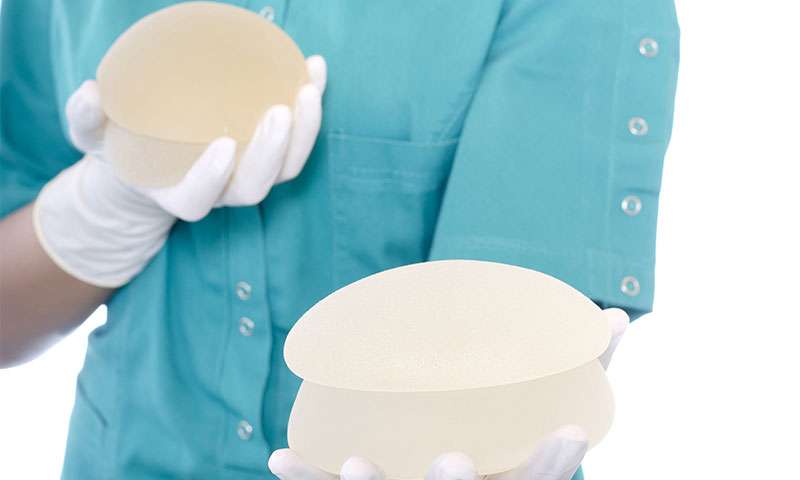
Breast implant, breast prosthesis, breast augmentation surgery

Breast augmentation is a surgical procedure designed to increase volume and enhance the beauty of the breasts. It improves not only the size of the breasts, but also their shape and firmness, in order to perfect, enhance or restore the balance of the figure. It is one of the most popular cosmetic surgery procedures, with a very high satisfaction rate.
Candidates for breast augmentation :
- Women with breast hypotrophy, i.e. small breasts even after their development period.
- Patients with breast malformation or asymmetry (e.g. tuberous breasts).
- Women with “empty” breasts, due to weight loss or childbirth.
- Women who want a more proportioned and attractive figure, and who will feel more comfortable and better about themselves after such an operation.
Today we have three effective and recognized methods for breast augmentation:
- Breast implants
- Lipofilling
- Composite augmentation
In some cases, certain procedures are offered at the same time as breast augmentation, such as a breast lift (for sagging breasts), liposuction of the axillary region (bulges or ectopic axillary glands) or modification of the size of the nipple or areola.
Techniques
Breast Augmentation with Implants
Breast implants differ in:
Their shape: round or anatomical, pear-shaped or teardrop.
Their casing: smooth, textured, or made of polyurethane foam.
Their content: filled with silicone gel, saline solution, or lightweight silicone (B-lite).
Their volume: varies based on the desired result and the patient’s build.
They can be placed either in front of or behind the pectoral muscle, as well as a combination of these two planes (Dual Plane). The procedure can be done through an incision below the breast (submammary), around the lower border of the areola, or in the armpit area.
Each choice of implant, location, and scar has its pros and cons. All these different options will be explained by your surgeon, who will guide you to the best choice based on your wishes, your health condition, and your anatomy. Implants are subject to wear and may need to be replaced at some point. This duration can vary greatly but averages between 10 and 15 years (30% at 15 years), although prophylactic change is no longer advised with the latest generation of implants.
Autologous augmentation through fat transfer or lipofilling
Using this technique, your breast size can be moderately increased by a maximum of one cup size per session. Your own fat is used, eliminating the need for a foreign body. Ideally, this harmonizes a disproportionate body by reducing excess fat and increasing breast volume. It involves liposuction from surplus areas like the abdomen, thighs, and flanks and the re-injection of the harvested fat. After an initial resorption phase of 3 months, the surviving re-injected fat is permanently integrated into the tissue. Depending on the desired volume, multiple sessions may be required.
Compared to augmentation with implants, it has several advantages:
- No implant, so no need for replacement due to wear
- Very natural result visually and to the touch
- Minimal scarring, just a few millimeters
- Great versatility in treating asymmetry
- Body contouring benefits (similar to liposuction)
Its disadvantages are :
- Maximum half to one cup size increase per session
- Variable results depending on the absorption rate (around 40%)
- Requires a good donor area
- Post-operative radiological monitoring needed
Composite augmentation
This final technique combines the previous two, yielding very natural and impressive results in a single operation. A moderate-sized implant is used to provide most of the volume and project the breasts upwards and forwards. Fat is used to camouflage these implants, giving the breasts a very natural appearance. It is a safe and very reliable technique, less dependent on fat absorption than isolated lipofilling.
Type of anesthesia
We usually use general anesthesia, but local anesthesia with intravenous sedation is possible in certain cases.
Duration of intervention
1 to 2 hours
Type of stay
Our breast augmentations are performed on an outpatient basis, meaning the patient can go home the same day after recovering from anesthesia. However, in some cases, especially if the procedure is more complex or if other procedures are performed at the same time, an overnight stay may be recommended for post-operative monitoring.
Recovery time
3 days to 2 weeks to return to work. 4 to 6 weeks to return to sports and for the residual swelling to disappear. 3 months to 1 year for scar improvement and final appearance.

Leman Aesthetic clinic offers the innovative, minimally invasive Mia Femtech™ technique.
FAQ
What is breast augmentation?
Breast augmentation is a surgical procedure performed in the field of plastic surgery aimed at increasing breast volume through the implantation of breast prostheses or fat transfer.
Who is the ideal candidate for breast augmentation?
Candidates are women who have hypoplasia (small breasts) after their development, a breast malformation or asymmetry, breasts that have lost volume due to weight loss or pregnancy, or those who desire a more harmonious silhouette.
What happens during the first consultation before surgery?
During this consultation, the surgeon will discuss the patient’s wishes, evaluate her health status and breast anatomy. Based on his clinical assessment, he will guide the patient on the best choice of technique and implant.
What techniques are used for breast augmentation?
Three methods are available: breast implant placement, autologous fat transfer (lipofilling), and composite augmentation.
What pain can be expected after surgery?
Post-operative pain varies depending on the case and the technique used. Generally, they are moderate and well-managed by painkillers prescribed by your surgeon.
Should you wear a bra after breast augmentation?
Yes, it is often recommended to wear a special compression bra for 4-6 weeks after the surgery to support and protect the breasts.
Are there any contraindications to breast augmentation?
Like any type of surgery, there are contraindications that will be discussed during the first consultation. These are generally related to pre-existing medical conditions.
What is the duration of the procedure?
The operation generally lasts between 1 to 2 hours.
Is the placement of drains necessary?
In principle, no, but in some cases, a drain may be inserted to prevent fluid accumulation. The surgeon will decide based on each situation.
When Is discharge expected after the procedure?
The procedure is mainly performed on an outpatient basis. However, depending on the operation and the patient’s well-being, a 24-hour hospital stay may be recommended.
Can pregnancy be considered after breast augmentation?
Yes, pregnancy is possible after augmentation. However, it is recommended to discuss with the surgeon any potential implications.
Is it possible to breastfeed after breast augmentation?
In most cases, breastfeeding is possible after breast augmentation. However, this depends on the method used and the procedure itself. It is crucial to discuss possible implications and precautions with your specialist.
How does body shape influence the choice of breast augmentation?
Every woman’s body shape is unique. The choice of breast augmentation method largely depends on the initial shape of the breasts, the desired size, and skin quality. A specialist will evaluate all these elements to recommend the best option.
What method of breast augmentation is recommended if I've experienced significant weight loss?
After significant weight loss, the skin may lose its elasticity. In these cases, a specialist may recommend a combination of implants and breast lift to achieve the best results in terms of shape and firmness.
What is unique about the Mia Femtech™ technique offered by Leman Aesthetic Clinic?
Mia Femtech™ is an innovative and minimally invasive technique performed under local anesthesia and sedation, in 15 minutes. It restores harmony to your body for a natural result. You can learn more by scheduling an appointment with our specialists.









